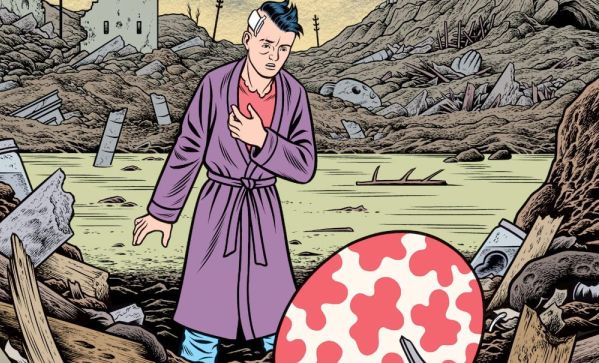For more than 80 years, the wild investigative-journo adventures of Belgian boy reporter Tintin and his canine sidekick Snowy have captivated a wide range of international audiences — sometimes even North Americans! Excuse the snark, but for many on this continent, Tintin knowledge has been limited to grade-school French class desperation tactics (use comic books to trick kids into reading). That will change significantly this week after the release of the live-action Speilberg/Jackson movie, The Adventures of Tintin. To help you appear knowledgeable during the inevitable Tintin onslaught, and perhaps assist you with some late-in-day holiday gift suggestions, DailyXY approached John Anderson, Tintinologist (an exclusive appointment, to be sure) at The Beguiling Books & Art. Here, John’s suggestions and rationales for the five best entries in author Hergé’s 23-volume series. —TheGuy@DailyXY
THE SECRET OF THE UNICORN (1942)
Tintin purchases a model ship as a gift for Captain Haddock, who recognizes it as The Unicorn, the ship sailed by one of Haddock’s illustrious ancestors. What’s more, the model contains a secret: directions to the treasure of the fearsome pirate Red Rackham! Written in WWII, in occupied Belgium, THE SECRET OF THE UNICORN eschews all topical elements in favour of pure escapism. It is wonderfully plotted, combining the story of Captain Haddock’s seafaring ancestor, Sir Francis Haddock, with Tintin’s encounters with criminals who are after Sir Francis’s treasure. Hergé’s careful research brings rich detail to the ships, while Haddock’s stirring tale of the battle with the pirates brings the story to life. Anyone who loves pirates will love this story — and who doesn’t love pirates?
THE SEVEN CRYSTAL BALLS (1948)
Seven archeologists open an Inca tomb in South America and are struck, one by one, with a mysterious illness upon returning Europe. After each researcher succumbs to the curse, the fragments of a crystal ball are found nearby. But as soon as Tintin begins to put the clues together to save their lives, his friend Professor Calculus disappears. Combining an interest in vaudeville magic shows with cursed tombs and exotic locations, this book has a constant air of suspense. It also has some great set pieces, such as Haddock bringing the house down in a music hall, the ball lightning that lifts Calculus into the air, and the image of a mummy creeping through a window towards a sleeping Tintin. This is the best example of Hergé’s ability to weave a thrilling, spooky mystery.
TINTIN IN TIBET (1960)
Tintin’s friend Chang is believed dead in an airplane crash in the Himalayas. Believed dead, that is, by everyone but Tintin, who goes on a quest into the snowy expanse of Tibet to rescue his friend. On the way he encounters the yeti, who turns out to be not so terrible. TINTIN IN TIBET is a gripping adventure pitting our heroes against the environment, but it is also a story of deep friendship, showing Tintin at his most courageous and selfless. He is convinced that Chang is alive, and will stop at nothing to save him. The monk who sees Tintin in a vision calls him “Pure Heart.” It is because of this book that the Dalai Lama presented an award to the Hergé Foundation in 2006.
THE CASTAFIORE EMERALD (1963)
Bianca Castafiore, opera singer and old friend of Tintin, invites herself to Captain Haddock’s Marlinspike estate, and quickly disrupts the peaceful atmosphere of Tintin and Haddock’s home. With her she brings a talkative parrot, a TV crew, journalists who are eager for any gossip… and her jewels, which are stolen — or are they? Set entirely in one location, THE CASTAFIORE EMERALD constantly subverts expectations. There are plenty of hints of danger and intrigue, but they all turn out to be innocent. In the end, similar to Wilkie Collins’ The Moonstone, there is no villain; still, along the way there is a very entertaining story that really lets its characters live and breathe. This volume will be appreciated by readers who are more interested in humour and character interaction than action and adventure.
TINTIN AND THE PICAROS (1976)
Tintin, Haddock and Calculus travel to the Central American country of San Theodoros to clear their names, and soon find themselves helping their old friend General Alcazar to overthrow the government. This book is a culmination of sorts, as many of the characters from previous books come together one last time. In some ways, TINTIN AND THE PICAROS is the most mature story. Tintin has grown up — he has given up adventure and is happy to stay at home. He only ends up taking part in this adventure because his friends are in trouble. Like the earliest Tintin books, this one is inspired by current events, but in a more skeptical way. At the end, the new regime of San Theodoros looks no different from the old regime readers saw at the beginning. This book will appeal to those who are interested in political commentary and parodies of current events.
What if you’ve read all the Tintin books? Where do you go next?
X’ED OUT [pictured] by Charles Burns has been called Tintin for grown-ups, and there is no doubt that it invokes the Belgian boy hero. Still, picture a grotesque and beautiful combination of Tintin and William S. Burroughs, and you’ll only begin to approach the ‘reality’ of award-winning cartoonist Burns’ weird worldview.
TINTIN: THE COMPLETE COMPANION by Michael Farr is a comprehensive look into the real-life sources of the characters, settings and themes in all of the Tintin books, including the 24th uncompleted adventure.
Finally, just released last month, THE ADVENTURES OF HERGÉ by Jose-Louis Bocquet, Jean-Luc Fromental and Stanislas is a graphic novel biography of Hergé told in the graphic “ligne claire” and storytelling manner of its very subject.
——————-
Image courtesy of Random House Canada



X’ED OUT is f’d up, and brilliant. Legal team at publisher must’ve watched it closely to make sure it was removed JUST ENOUGH from Tintin. I mean, look at those mushrooms!!